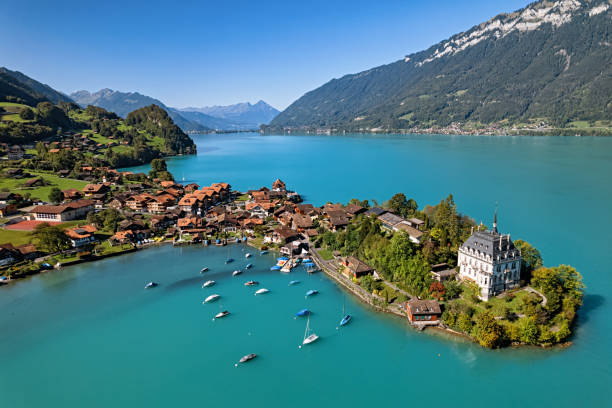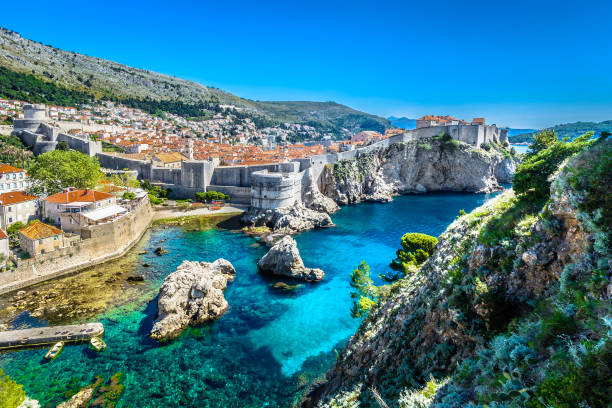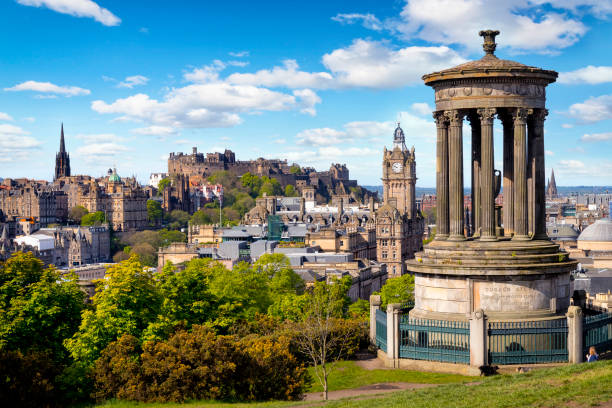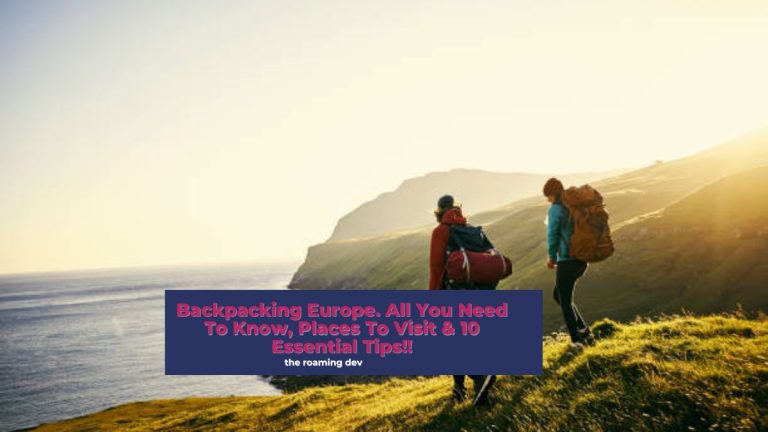Backpacking is one of the most popular forms of tourism in Europe. So, why do you take a backpacking trip across Europe and see the world?
It’s a great idea to see Europe’s beauty adorned by its varied geography and the excitement of its cities. The diversity makes it excellent for worldly travelers or newcomers to the world of travel.
While you plan to explore backpacking Europe, be ready to explore the charming gondolas of Venice and the crowded sidewalks of Berlin. Every corner of this destination will leave you wanting more.
Now, how do you begin backpacking in Europe? How does one choose from the myriad of available choices, and what should one consider once one decides to travel?
This guide will provide all the information you need. Also, the 10 tips for traveling smart and being safe will provide you with the information required to make your trip extraordinary and enjoyable. Here we go.
Why Backpack Europe?
Europe is a unique continent for tourists as it has ancient cities, beautiful countryside, and active cultures, all within a reasonable distance from each other.
The train and bus connections are fairly good, and the low-cost airlines ensure that one can travel around the continent with modest means.
Besides, Europe is considered one of the safest continents in the world, attracting tourists, including singles and groups.
Must-Visit Destinations
1. Paris, France

Paris, the capital of France, is a city that is overwhelmed with sights such as the Eiffel Tower, the famous Louvre Museum, and the Montmartre district.
It is also important to try French food and cakes before leaving the place.
2. Amsterdam, Netherlands

This city is famous for its canals, museums, and nightlife.
It’s relatively more friendly for backpackers than the rest of Europe. You can choose to ride bicycles across the city and visit attractive districts.
3. Rome, Italy

If you like discovering history, you should not miss visiting Rome and its most famous places, including the Colosseum, the Vatican, and the Pantheon.
In Rome, you will learn a lot about the culture and try delicious Italian dishes.
4. Barcelona, Spain

As one of the most famous cities in Spain, Barcelona has the astonishing buildings of Antoni Gaudí, such as Sagrada Família and Park Güell.
It also offers beach entertainment and nightclubs.
5. Prague, Czech Republic

Prague has excellent Gothic architecture and is relatively cheap compared to other cities, so backpackers prefer it.
You can opt to visit Old Town, walk the Charles Bridge, and see the Prague Castle.
6. Berlin, Germany

One can hardly expect to discover a city that has a long history and a great culture yet bears a modern outlook in the present-day world.
Surprisingly, that is true for Berlin. Make it to Berlin while backpacking Europe and visiting the Wall and the Gate.
Still, there are so many other museums besides experiencing the explicit nightlife in the nightclubs.
7. Budapest, Hungary

Hungary is well known for its spas, thermal baths, and architectural masterpieces.
Most of its lively areas are located in ruins. The presence of the Danube River is more than an advantage to the city’s overall aesthetics.
8. Interlaken, Switzerland

Interlaken is a place where those who arrive in the country in search of the best and most exciting outdoor activities start their adventure.
Here, you will walk and ski.
9. Dubrovnik, Croatia

Isn’t it great to have a place where you can consider the medieval walls? Dubrovnik has one that is well-preserved, and the view of the Adriatic Sea is breathtaking.
Also known as the shooting place for the famous show “Game of Thrones,” you will be thrilled by the imagination that you’re acting in a movie.
10. Edinburgh, Scotland

In Edinburgh, the old and the new are equally represented, making it a perfect place for a holiday.
Visit the most popular tourist attraction, Edinburgh Castle, walk through the Royal Mile, and, of course, enjoy what Scottish culture has to offer in terms of cuisine.
10 Tips for Backpacking Through Europe
Europe is a dream destination for backpackers, offering diverse cultures, landscapes, and experiences. To make the most of your trip, follow these comprehensive tips:
1. Pick Your Season Wisely
Your choice of when to travel is very important because it determines the kind of experience you are going to have.
For summer travel, eastern Europe is interesting, with low prices and beautiful places, including the Balkan coastline, Slovenian mountains, and Baltic cities.
The best option is the Mediterranean when, with the advent of autumn, the flow of tourists to the coast is minimal.
The coastlines and islands of southern Europe are less busy, and the cities have started to reveal their character, for example, in Spain and Italy.
Winter is great for skiing in the Alps or Pyrenees or going out on New Year’s Eve in various European cities.
The best time for Northern Europe is spring since people enjoy the long daylight, and prices are relatively low in countries such as the Netherlands, Scandinavia, France, and the British Isles.
2. Take the Train
Traveling by train is one of the best ways to explore Europe, allowing you to appreciate its diverse landscapes at ground level.
An Interrail Global pass (for Europeans) or a Eurail pass (for non-Europeans) offers unlimited train travel across multiple countries.
Overnight trains are a great way for budget travelers to save on accommodation costs. Additionally, consider budget flights for specific destinations farther apart to maximize your itinerary.
3. Be Savvy About Accommodation
Accommodation options for European travelers include several popular hostel brands with affordable rooms and even private rooms.
Either way, homestays and Airbnb can be cheaper than hotels and provide more added value. Another budget-friendly hack is if you are willing to compromise on accommodation.
You can sleep in a tent, and then some of the best-equipped campsites are habitable.
Remember, the summer season is also a good time to look for accommodation since university dormitories might be cheaper in some countries.
On the other hand, whether you choose a luxury hotel or a budget motel, it is always wise to make early bookings, especially when traveling during the peak season.
4. Plan Your Trip Around a Festival
Europe is a place that is rich in festivals, which can make your trip quite interesting.
Try to organize a trip to visit Ireland on St. Patrick’s Day, when Dublin turns into a sea of clovers and foam on the streets, and people drink green beer and Guinness.
The Roskilde Festival in Denmark is as big as Glastonbury, and attractions such as the mass naked run are exhibited during the event.
Italy’s Ivrea entertains the world with the peculiar yet exciting Battle of the Oranges. These festivals give a true idea of local customs and traditions and can be worth visiting.
5. Eat Like a Local, Including Trying Street Food
Europe boasts some of the world’s greatest cuisines, and eating like a local can be both affordable and enriching. Avoid tourist traps and seek out local dining spots.
Enjoy tapas in Spain, savor Italian cuisine at a trattoria, or try smørrebrød in Denmark.
Don’t miss breakfast favorites like oven-fresh croissants in France or a hearty “full English” in the UK. When you dine where locals do, you’ll experience authentic flavors without breaking the bank.
Europe’s street food scene is vibrant and offers delicious, affordable meals. Major cities like London feature gourmet food trucks serving a variety of cuisines.
Street food is often cheaper and can be as good or better than restaurant offerings. Embrace the opportunity to try local specialties in a casual setting.
6. Find the Freebies
Being on a budget doesn’t mean missing out on iconic European experiences.
Many cities offer free walking tours, and in places like Rome, you can partake in the tradition of aperitivo.
London’s numerous free museums are perfect for culture enthusiasts, and many European cities have markets where you can buy fresh ingredients to cook your meals.
Resources like the Rough Guides provide lists of free things to do in major cities like Paris, Barcelona, Lisbon, and Berlin.
7. Get Outdoors and Stay Safe
Nevertheless, Europe’s cities are not the only attraction; nature is equally appealing. Partake in activities such as horse riding in the Rila, Bulgaria, surfing on the Alentejo coast of Portugal, or skiing in Norway.
Moreover, experience some of the most beautiful phenomena of northern nature, for instance, the Aurora Borealis in Swedish Lapland.
Traveling also requires one to be safe at all times. Don’t carry much money on you, be careful when choosing a hostel, and use public transport when moving around by transport.
Also, don’t flaunt your camera or your smartphone.
Lock your bags, especially during overnight travel, and have copies of your documents stored online. These precautions will go a long way in preventing any mishap on the trip.
8. Allow Yourself the Odd Splurge
Budget travel can make occasional splurges even more enjoyable.
Treat yourself to a private hostel room or boutique hotel for a night, indulge in a gourmet meal, or experience a unique activity like watersports in Croatia.
These occasional treats can add a touch of luxury to your trip without significantly impacting your budget.
9. Stay Up Late
Europe’s nightlife is legendary, offering something for everyone. Enjoy the hipster bars in Berlin and London, experience flamenco in Seville, or explore Italy’s vibrant enotecas.
Follow in the footsteps of famous literary figures by visiting historic pubs in Oxford or Brussels. Europe’s night scenes are rich with history and culture, providing memorable experiences that extend well into the early hours.
10. Hit the Beach
After bustling city visits, Europe’s beaches offer a perfect retreat.
For quieter, wilder beaches, head to Formentera in Spain, Croatia’s Adriatic coast, or Italy’s numerous coastal spots.
Montenegro’s Mogren Beach, part of the Budva Riviera, offers a serene escape from the crowds. Whether you’re looking to relax or engage in water activities, Europe’s beaches cater to all preferences.
The Bottomline
Of course, it’s possible to take longer trips, and although they initially can be relatively costly, they have many benefits.
It’s even better when the trip spans two weeks or more because it enables one to spend ample time in different cities or countries.
As you do backpacking Europe, be ready to adjust your schedule depending on tips obtained from other travelers and places you wish to explore. It’s good to do backpacking without a tight schedule.
Ultimately, take into account the weather or other conditions at places you choose to visit while backpacking.
Activities also matter. In some places like Norway or Switzerland, the weather may be warm even in summer, and therefore, one may need to wear warm clothing.
Carry light and multiple clothing items that can be worn over one another, and have strong shoes for ground activities.
Effective packing makes you comfortable and ready for different weather and events that you’ll encounter when traveling.
Also Read:
- 20 Best Places to Live in Europe: Travel + Leisure
- The 7 Best Digital Nomad Visas in Europe
- 15 Best Countries For Americans To Move To From USA in 2024



